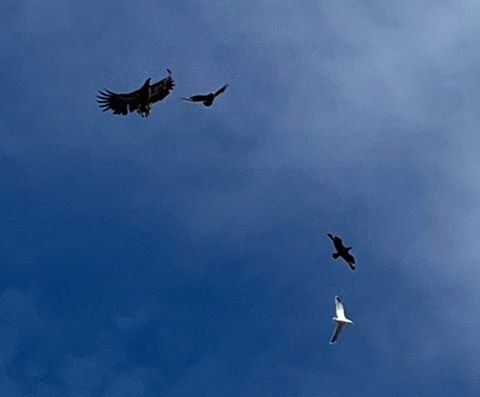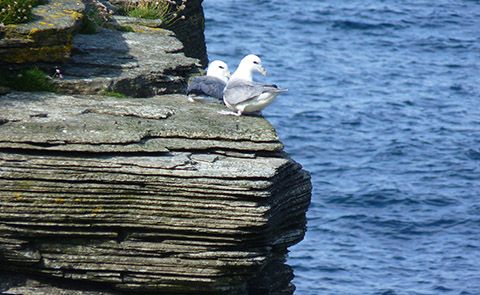Scottish Cliffs and Birds

When thinking about the beauty of Scotland and the islands which pepper the surrounding seas, what comes to mind are the towering cliffs and, of course, the amazing birdlife which inhabits these coastlines.
On the cruise around the Scottish islands our first real upclose view of the magnificent coast was on Papa Westray in the Orkney Island group. This was also our introduction to the numerous species of birds which live on these magnificent precipices.

Of course, everyone was eager to see a puffin!! The world's cutest bird. But as it was the end of the breeding season there were few around to oblige with a photo shot. Fortunately our friend Deb was carrying her superduper camera and managed to get this shot!
Yes, they really are very cute and quite small. There are different types of puffins and I think the ones we saw were Atlantic Puffins who average about 27cm in height and weigh about 600 grams!

On Papa Westray we were able to see some nesting pairs of Fulmars who definitely live on the edge!

Northern Fulmars are monogamous and mate for life—and they can live about 60 years. They are famously faithful to their nest sites as well: one study found that more than 99% of birds returned to the previous season’s nest site with the same mate. They nest in colonies ranging from a few pairs to many thousands, and their nests may be just a few feet apart. When a pair returns to its nest cliff in spring, male and female display to one another by stretching out their necks and wagging their heads back and forth rhythmically, giving a cackling call. They also preen one another. They gather at the nest site and mate often, and males fend off any rival males at this time. The pair then departs the nest site for several weeks, during which time the female eats well, to obtain enough calcium to produce her single egg. The male usually begins incubation as soon as the female lays her egg, so she can return to sea to feed and regain strength. The parents take turns traveling to sea and provisioning the chick, which leaves the nest cliff soon after fledging. Fulmar parents generally forage in the vicinity of their colonies but sometimes travel more than 600 miles round trip to procure food for the nestling. After the nesting season, fulmars, disperse toward traditionally productive foraging grounds and spend the rest of the year on the open ocean. Because their prey resources shift during the nonbreeding season, the birds must move around quite a bit to stay nourished.1

Whilst the Puffins are cute and the Fulmars loyal- the Guillemots have style!!


Of course, there is nothing to equal watching birds in full flight over the sea...

To see the bird life up much closer we were taken out in zodiacs to cruise up and down along the cliffs. I made a little video to show you puffins at sea where you can see the rafts of puffins floating somewhat precariously in the water and taking off into flight in their clumsy style.
The quality of the images is not good but I am sure you will appreciate how hard it was to photograph little puffins floating about in the swelling waters off the coast of Scotland ... whilst perched (that's me) on the side of a rubber Zodiac!!
The variety of seascapes around Scotland is incredible and the cliff faces continued to amaze me for the length of the cruise.

I will conclude today with another video this time taking you in the Zodiac to simulate a little of the experience we had when cruising around the coastline of Scotland.
The segue from this post to the next one on the Scottish adventure is to visit the remote and fabulously interesting island of St Kilda where the locals lived on a diet of birds for hundreds, probably thousands of years. And yes they ate the puffins!! As they are so small they were only a mid morning snack like a packet of crisps!!! I'll be back in a couple of days to show and tell you all about St Kilda.
Credit
1. allaboutbirds.org/guide/Northern_Fulmar/lifehistory
